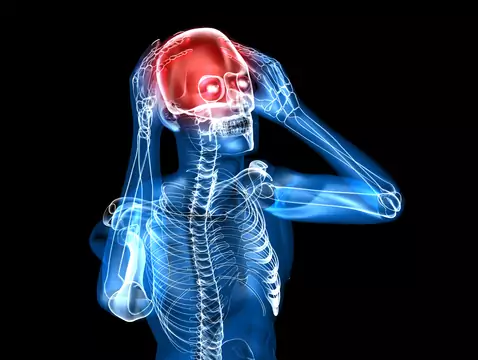
Rubella - rash childhood disease - causes, symptoms, diagnosis, treatment
Rubella is a common viral disease of childhood. Rubella mainly affects older children and adolescents.

Migraine in children - causes, symptoms, diagnosis, treatment
Headaches are one of the most common reasons for parents to visit the paediatrician with their child. When they are paroxysmal, accompanied by photophobia, hypersensitivity to sounds, tastes, nausea,...

Migraine in a child - causes, symptoms, diagnosis, treatment
Migraine is a fairly common cause of paroxysmal headaches in children and adolescents - in Poland it affects approximately 4.4% of children. The pain is paroxysmal, usually bilateral, usually...

Three-day fever (sudden erythema) - causes, symptoms, diagnosis, treatment
Three-day fever, or sudden erythema, is an acute, rash-like viral illness. Infants and young children (usually 6-18 months of age) are mainly affected. Incidence after 4 years of age is rare....

Nutrition and recommendations in nephrotic syndrome in children
Nephrotic syndrome is a clinical condition with various causes in which there is proteinuria >50mg/kg body weight/day or >3.5g/day, hypoalbuminaemia

Measles - causes, symptoms, diagnosis, treatment, complications
Measles is a viral systemic disease that is highly infectious and presents with a coarse-spotted (sometimes maculopapular) rash. In the prevention of measles, the most important thing is vaccination....

Gastro-oesophageal reflux in children aged 2-12 years (GERD) - nutrition and recommendations
Gastro-oesophageal reflux is the leakage of food contents into the oesophagus due to reduced tension of the lower oesophageal sphincter. Gastroesophageal reflux disease (GERD) is the leakage of...

Gastro-oesophageal reflux in infants and children under 2 years of age (GERD) - nutrition and recommendations
Gastroesophageal reflux is the passage of food content into the oesophagus. It is a physiological process that occurs several times a day in healthy infants, children and adults. Sometimes infants...

Febrile convulsions - causes, symptoms, diagnosis, treatment
Febrile convulsions are a fairly common childhood problem of great concern to parents and carers. They are the most common cause of infantile and early childhood convulsions. They occur in febrile...

Helicobacter pylori eradication - is it necessary?
Helicobacter pylori infection is common in European countries. In Poland up to 1/3 of children become infected before the age of 18. The bacterium can be the cause of, among other things, gastric and...

Leukaemia in children - causes, symptoms, diagnosis, treatment
Leukaemias are the most common childhood malignancies. They originate in the haematopoietic system and originally occupy the bone marrow. There are different types of leukaemia. In children, ALL...

Infectious measles - causes, symptoms, diagnosis, treatment
Measles is one of the infectious viral rash diseases of childhood and adolescence (mainly affecting children under 15 years of age); although unvaccinated adults can also become ill. The main...

Pharyngitis and tonsillitis in children - causes, symptoms, diagnosis, treatment
Angina is an acute inflammation of the mucous membrane and lymphatic tissue of the palatine tonsils and the pharyngeal tonsil. Pharyngitis is an acute inflammatory process involving the mucous...

Duchenne muscular dystrophy - causes, symptoms, diagnosis, treatment
Duchenne muscular dystrophy is the most severe form of muscular dystrophy. It is caused by a mutation of a gene located on the X chromosome. Boys are affected; women may be carriers of the mutated...

Mumps - causes, symptoms, diagnosis, treatment
Mumps or parotitis is a viral infectious disease of childhood, the main symptom of which is enlargement and pain in the salivary glands, usually the parotid glands. The disease usually affects...

Headaches - causes, symptoms, diagnosis, treatment
A headache is a common complaint with which both children and adults visit the doctor. Also infants can suffer from headaches - the diagnosis in this case is presumptive.

Lymphadenopathy in children - causes, symptoms, diagnosis, treatment
Lymphadenopathy is an enlargement of the lymph nodes. It is a common symptom in children that causes concern for parents and always requires diagnosis. Lymphadenopathy can be generalised (e.g. in the...

Sudden hearing loss - causes, symptoms, diagnosis, treatment
Hearing is one of the most important human sensory organs. The appearance of any hearing problems or the complete loss of hearing is not only a health problem, but also a social one.

Alexander's disease - definition, causes, course, imaging, treatment
Alexander's disease was first described in 1949. The disease affects people of all ages. It is classified as a demyelinating disease (breakdown of myelin sheaths in the nervous system occurs)....

Chickenpox - causes, symptoms, diagnosis, treatment, risk of complications
Chickenpox (chickenpox) is a highly contagious disease that is caused by a virus - Varicella Zoster. Infection is through the droplet route. It affects everyone from newborns to the elderly, with...



